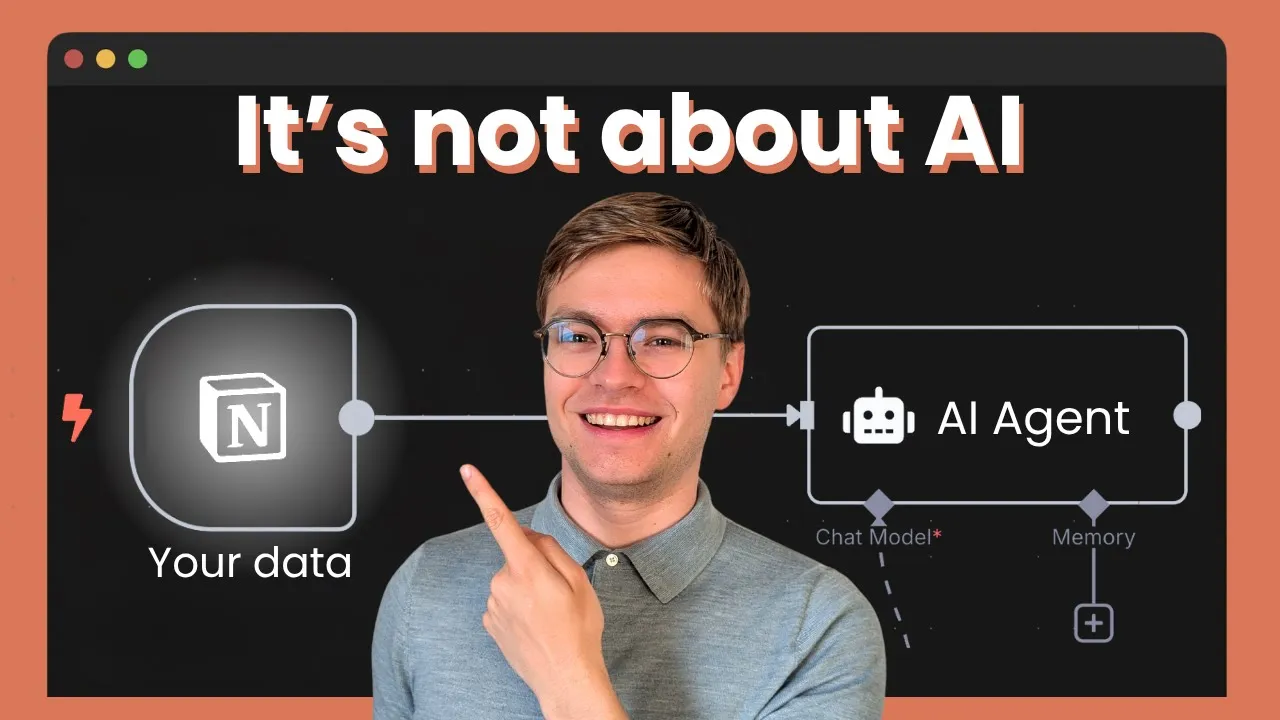Why AI Automation Fails Without Good Input Data
Gurus are promising you can automate everything with AI—generate hundreds of blogs, get thousands of leads, make millions automating video creation. Be honest with me though, do you really believe it’s that simple? There’s a fundamental lie at the heart of most AI automation advice, and understanding it can mean the difference between creating valuable content and spamming the internet with garbage nobody will read.
The Automation Illusion
The AI automation industry wants you to believe the magic is in their tools—the workflow builders, the AI agents, the orchestration platforms. They sell you on the sophistication of their systems, the elegance of their automations, the power of their AI models. But they’re hiding the most important truth: without good input data, these workflows just generate garbage.
Think about what AI models actually are—they’re statistical engines that find patterns in data and generate likely outputs based on those patterns. When you feed them generic prompts or minimal information, they produce exactly what you’d expect: average, unremarkable content that sounds like everything else on the internet. The tools themselves aren’t creating value—they’re just processing whatever you give them.
Why Input Data Is Everything
The real value in any AI automation workflow lies in the input data. Not the prompts you write, not the workflow you design, not the AI model you choose—but the actual substance you’re feeding into the system. This is the secret that automation gurus don’t teach because it’s not as sellable as a shiny new tool.
When you provide rich, expert-level input data—like detailed transcripts from your own presentations, insights from your real experience, or knowledge you’ve gained through years of practice—AI can transform that into valuable content. But when you provide generic inputs or let AI generate its own source material, you get generic outputs that add to the noise rather than cutting through it.
The Statistical Reality of AI
Understanding that AI models are statistical systems is crucial. They don’t create new knowledge—they recombine patterns from their training data based on probabilities. When you give them unique, high-quality input, they can recombine those patterns in useful ways that maintain the essence of your expertise. When you give them nothing special, they default to the most common patterns—resulting in content that reads like a thousand other AI-generated pieces.
This statistical nature means that if you’re relying on AI for both the automation and the input data, you’re guaranteed to get something completely average. How many people are doing exactly the same thing? How many blogs with identical “insights” are being published daily? The answer is thousands, and they all sound exactly the same because they’re all drawing from the same statistical average.
Understanding why most AI projects fail comes down to this fundamental misunderstanding of how to create value with AI systems.
The Quality Multiplication Effect
Good input data doesn’t just improve your output linearly—it has a multiplication effect. When you feed expert knowledge into an AI system, every piece of content it generates carries traces of that expertise. Your unique perspectives, hard-won insights, and distinctive voice get woven into the output in ways that generic prompting could never achieve.
This multiplication effect is why some AI-generated content feels valuable while most feels like spam. The difference isn’t in the AI tool or the automation workflow—it’s in what’s being fed into the system. Expert input creates expert-adjacent output. Generic input creates generic output. There’s no escaping this fundamental equation.
Building Value-First Automations
To create AI automations that actually provide value, you need to flip your thinking. Instead of starting with “what can I automate?”, start with “what unique value do I have to share?” Instead of focusing on the workflow design, focus on the quality of information flowing through it. Instead of optimizing for quantity, optimize for substance.
This means your automation strategy should center on capturing and leveraging your actual expertise, experience, and insights. Whether that’s through detailed transcripts of your presentations, comprehensive notes from your projects, or structured captures of your learning—the goal is to feed AI systems with material that no one else has.
The Respect Equation
Creating valuable AI automation is ultimately about respect—respect for yourself and respect for your audience. When you publish content under your name, you’re putting your reputation behind it. Do you want that content to be generic AI slop that anyone could have generated? Or do you want it to represent your actual knowledge and provide real value?
Respecting your audience means not wasting their time with content that doesn’t deserve to exist. It means using automation to amplify your expertise, not to replace it. It means being a real automator who enhances value delivery, not a spammer who pollutes the internet with more noise.
To see exactly how I implement these principles in my own content automation workflow, including real examples of high-quality versus low-quality outputs, watch the full video tutorial on YouTube. I demonstrate the dramatic difference that input data quality makes and show you how to build automations that actually respect both your time and your audience’s attention. Ready to become a real automator instead of a spammer? Join the AI Engineering community where we focus on creating valuable, expertise-driven content at scale.

